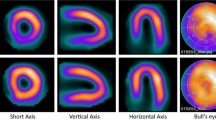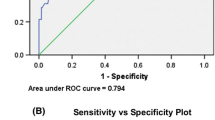Abstract
Purpose
Guidelines propose different rest–stress activity ratios (RSAR) for one-day stress-first SPECT myocardial perfusion imaging (MPI), but evidence is limited. Our aim was to determine and validate the minimal RSAR resulting in the same diagnostic outcome in one-day stress-first SPECT MPI.
Methods
Forty-seven patients referred for rest after stress CZT-SPECT/CT MPI were prospectively included. Rest acquisitions were performed 3 h after stress. In addition to the stress and rest acquisitions, the first 22 patients underwent an additional acquisition prior to the rest injection to determine the remaining stress activity. Next, we simulated six RSARs varying from 1.0 to 3.5 in both patients and a phantom and compared the images to those using the reference RSAR of 4.0. Differences in summed difference score (SDS) >2 or ischemic defect interpretation were considered to significantly influence diagnostic outcome. After deriving the minimal RSAR, it was validated in 25 additional patients by comparing it to a RSAR of 4.0.
Results
After 3 h only 26% of the stress activity was still present in the myocardium. SDS differences >2 were found in one (4%) patient using RSAR of 3.5, 2.5 and 2.0, in three (12%) using 1.5 and in five (20%) using SRAR of 1.0. These results were consistent with the phantom study showing SDS differences >2 for RSARs ≤1.5 and with the visual interpretation which showed an increased number of deviating scans for RSAR 1.0. Validating the RSAR of 2.0 resulted in a different SDS in one patient (SDS of 30 versus 11). Moreover, two scans were interpreted as ischemic instead of normal when using RSAR 2.0 and in two other scans the opposite was the case.
Conclusions
A RSAR of 2.0 in one-day stress-first MPI SPECT seems sufficient to obtain accurate diagnostic outcomes and is therefore recommended to reduce radiation exposure.






Similar content being viewed by others
Abbreviations
- CT:
-
Computer tomography
- iTPD:
-
Ischemic total perfusion deficit
- MPI:
-
Myocardial perfusion imaging
- SDS:
-
Summed difference score
- SPECT:
-
Single photon emission computed tomography
- RSAR:
-
Rest-stress activity ratio
- TPD:
-
Total perfusion deficit
References
Montalescot G, Sechtem U, Achenbach S, Andreotti F, Arden C, Budaj A, et al. 2013 ESC guidelines on the management of stable coronary artery disease: the task force on the management of stable coronary artery disease of the European Society of Cardiology. Eur Heart J. 2013;34:2281–329.
Flotats A, Knuuti J, Gutberlet M, Marcassa C, Bengel FM, Kaufmann PA, et al. Hybrid cardiac imaging: SPECT/CT and PET/CT. A joint position statement by the European Association of Nuclear Medicine (EANM), the European Society of Cardiac Radiology (ESCR) and the European Council of Nuclear Cardiology (ECNC). Eur J Nucl Med Mol Imaging. 2011;38:201–12.
Underwood SR, Anagnostopoulos C, Cerqueira MD, Ell PJ, Flint EJ, Harbinson M, et al. Myocardial perfusion scintigraphy: the evidence. Eur J Nucl Med Mol Imaging. 2004;31:261–91.
Gowd BMP, Heller G V, Parker MW. Stress-only SPECT myocardial perfusion imaging: a review. J Nucl Cardiol. 2014;7–12.
Nakazato R, Berman DS, Hayes SW, Fish M, Padgett R, Xu Y, et al. Myocardial perfusion imaging with a solid-state camera: simulation of a very low dose imaging protocol. J Nucl Med. 2013;54:373–9.
Van Dijk JD, Jager PL, Ottervanger JP, Slump CH, de Boer J, Oostdijk AHJ, et al. Minimizing patient-specific tracer dose in myocardial perfusion imaging using CZT SPECT. J Nucl Med Technol. 2015;43:36–40.
Einstein AJ, Blankstein R, Andrews H, Fish M, Padgett R, Hayes SW, et al. Comparison of image quality, myocardial perfusion, and left ventricular function between standard imaging and single-injection ultra-low-dose imaging using a high-efficiency SPECT camera: the MILLISIEVERT study. J Nucl Med. 2014;55:1430–7.
Henzlova MJ, Croft LB, Duvall WL. Stress-only imaging: faster, cheaper, less radiation. So what’s the hold up? J Nucl Cardiol. 2013;20:17–9.
Henzlova MJ, Duvall WL, Einstein AJ, Travin MI, Verberne HJ. ASNC imaging guidelines for SPECT nuclear cardiology procedures: stress, protocols, and tracers. J Nucl Cardiol. 2016;23:640–2.
Verberne HJ, Acampa W, Anagnostopoulos C, Ballinger J, Bengel F, De Bondt P, et al. EANM procedural guidelines for radionuclide myocardial perfusion imaging with SPECT and SPECT/CT: 2015 revision. Eur J Nucl Med Mol Imaging. 2015;42:1929–40.
DePuey EG, Ata P, Wray R, Friedman M. Very low-activity stress/high-activity rest, single-day myocardial perfusion SPECT with a conventional sodium iodide camera and wide beam reconstruction processing. J Nucl Cardiol. 2012;19:931–44.
Heo J, Powers J, Iskandrian AE. Exercise-rest same-day SPECT sestamibi imaging to detect coronary artery disease. J Nucl Med. 1997;38:200–3.
van Dijk JD, Borren NM, Mouden M, van Dalen JA, Ottervanger JP, Jager PL. Effect of a patient-specific minimum activity in stress myocardial perfusion imaging using CZT-SPECT: prognostic value, radiation dose, and scan outcome. J Nucl Cardiol. 2018;25:26–35.
Koopman D, van Dalen JA, Slump CH, Lots D, Timmer JR, Jager PL. Impact of image processing in the detection of ischaemia using CZT-SPECT/CT. Nucl Med Commun. 2015;36:60–8.
Verberne HJ, Acampa W, Anagnostopoulos C, Ballinger J, Bengel F, De Bondt P, et al. EANM procedural guidelines for radionuclide myocardial perfusion imaging with SPECT and SPECT/CT. Available at: https://eanm.org/publications/guidelines/2015_07_EANM_FINAL_myocardial_perfusion_guideline.pdf. Accessed on October 1, 2018.
Holly TA, Abbott BG, Al-Mallah M, Calnon DA, Cohen MC, DiFilippo FP, et al. Single photon-emission computed tomography. J Nucl Cardiol. 2010;17:941–73.
Berman DS, Abidov A, Kang X, Hayes SW, Friedman JD, Sciammarella MG, et al. Prognostic validation of a 17-segment score derived from a 20-segment score for myocardial perfusion SPECT interpretation. J Nucl Cardiol. 2004;11:414–23.
Berman DS, Kang X, Gransar H, Gerlach J, Friedman JD, Hayes SW, et al. Quantitative assessment of myocardial perfusion abnormality on SPECT myocardial perfusion imaging is more reproducible than expert visual analysis. J Nucl Cardiol. 2009;16:45–53.
Leslie WD, Tully SA, Yogendran MS, Ward LM, Nour KA, Metge CJ. Prognostic value of automated quantification of 99mTc-sestamibi myocardial perfusion imaging. J Nucl Med. 2005;46:204–11.
Xu Y, Hayes S, Ali I, Ruddy TD, Wells RG, Berman DS, et al. Automatic and visual reproducibility of perfusion and function measures for myocardial perfusion SPECT. J Nucl Cardiol. 2010;17:1050–7.
Nkoulou R, Pazhenkottil AP, Kuest SM, Ghadri JR, Wolfrum M, Husmann L, et al. Semiconductor detectors allow low-dose-low-dose 1-day SPECT myocardial perfusion imaging. J Nucl Med. 2011;52:1204–9.
Cerqueira MD, Nguyen P, Staehr P, Underwood SR, Iskandrian AE. Effects of age, gender, obesity, and diabetes on the efficacy and safety of the selective A2A agonist Regadenoson versus adenosine in myocardial perfusion imaging. JACC Cardiovasc Imaging. 2008;1:307–16.
Danias PG, Ahlberg AW, Travin MI, Mahr NC, Abreu JE, Marini D, et al. Visual assessment of left ventricular perfusion and function with electrocardiography-gated SPECT has high intraobserver and interobserver reproducibility among experienced nuclear cardiologists and cardiology trainees. J Nucl Cardiol. 2002;9:263–70.
Henzlova MJ, Cerqueira MD, Hansen CL, Taillefer R, Yao S-S. Stress protocols and tracers. ASNC. J Nucl Cardiol. 2009;16:331.
Author information
Authors and Affiliations
Corresponding author
Ethics declarations
All procedures performed were in accordance with the ethical standards of the institutional and/or national research committee and with the 1964 Helsinki declaration and its later amendments or comparable ethical standards. Informed consent was obtained from all individual participants included in the study.
Disclosures
None of the authors have anything to disclose.
Electronic supplementary material
ESM 1
(DOCX 751 kb)
Rights and permissions
About this article
Cite this article
van Dijk, J.D., van Dalen, J.A., Knollema, S. et al. Minimal rest activity for SPECT myocardial perfusion imaging in a one-day stress-first protocol. Eur J Nucl Med Mol Imaging 46, 1248–1256 (2019). https://doi.org/10.1007/s00259-018-4206-x
Received:
Accepted:
Published:
Issue Date:
DOI: https://doi.org/10.1007/s00259-018-4206-x




